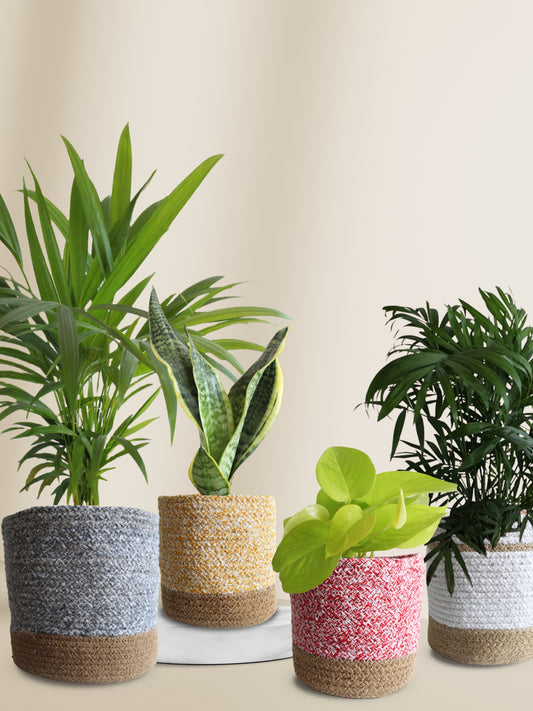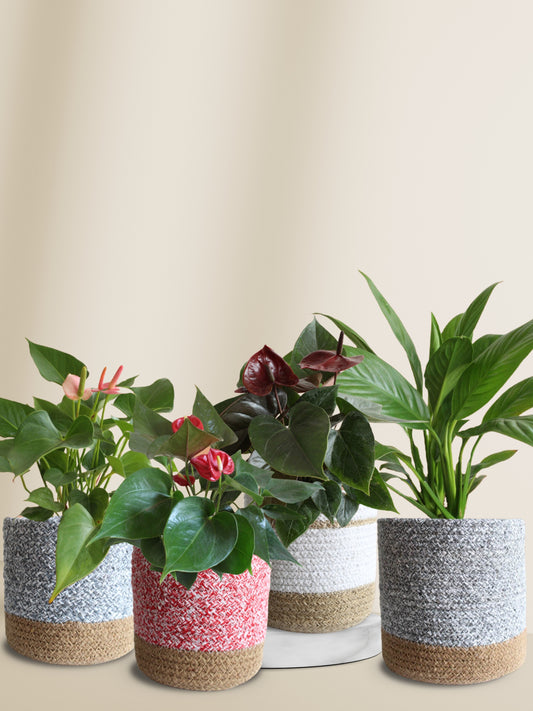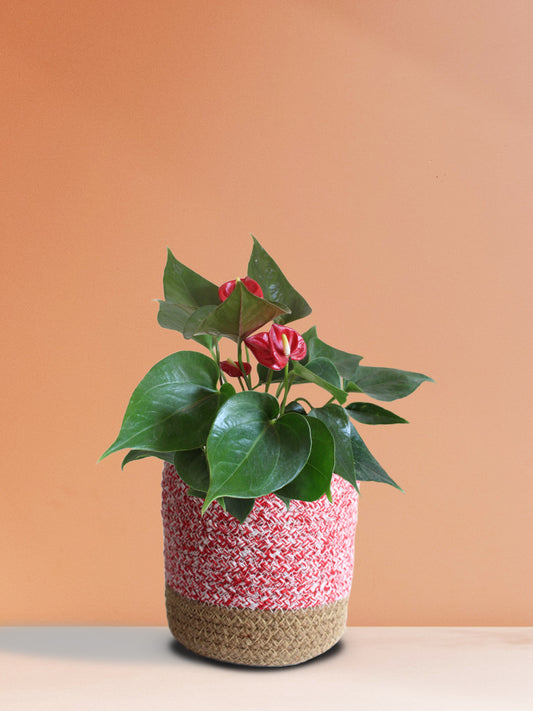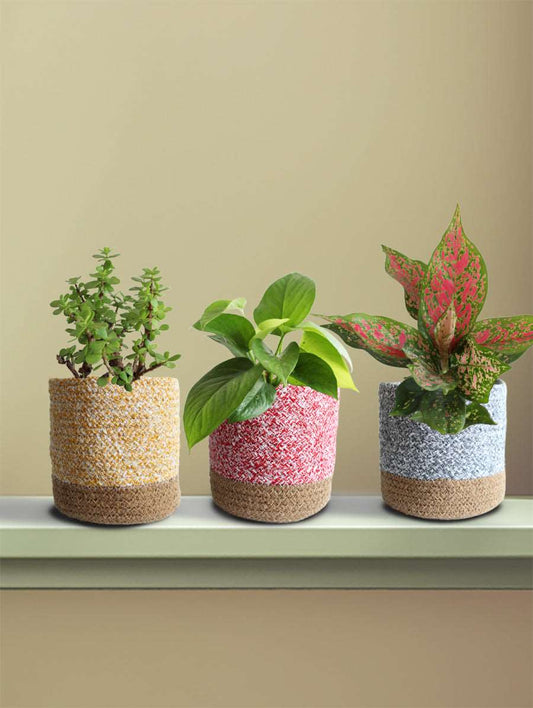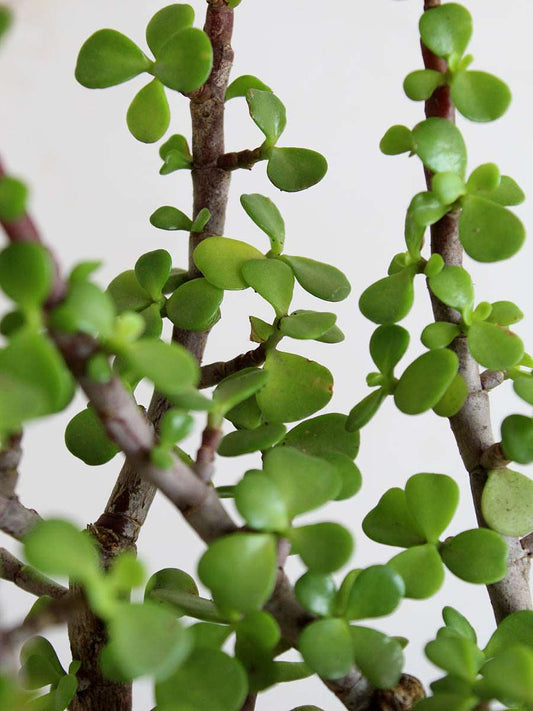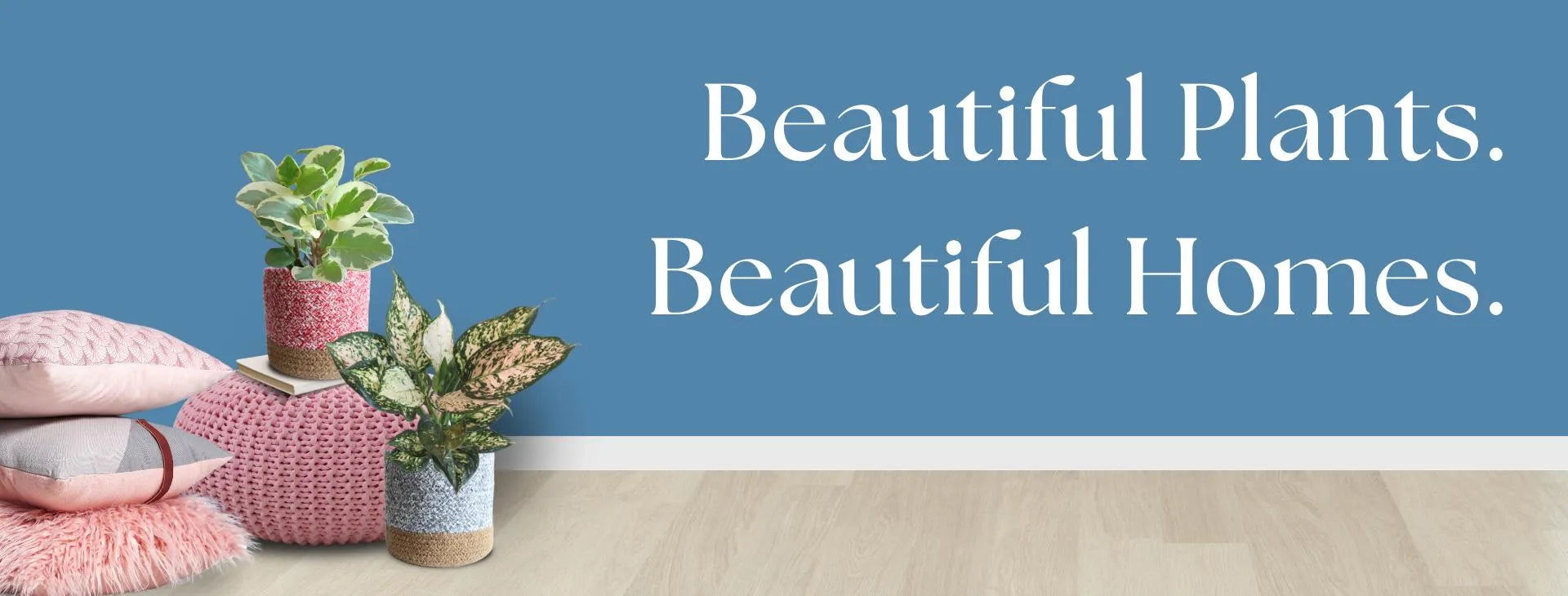
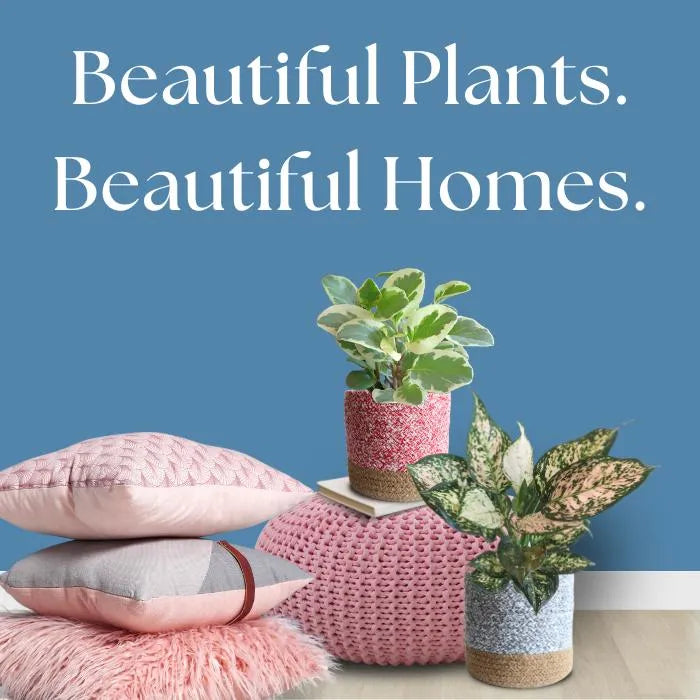
-
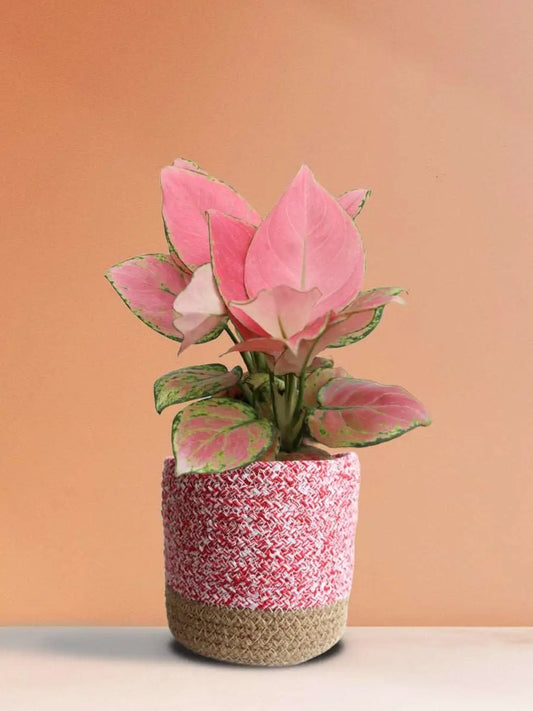
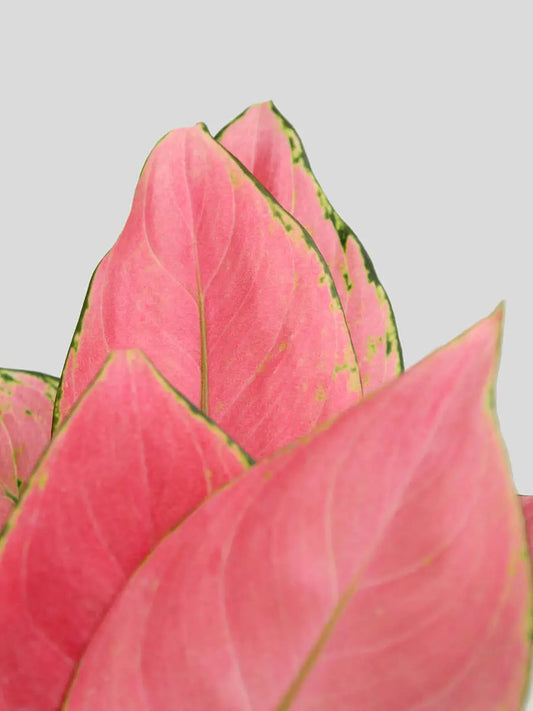 20% Off
20% OffAglaonema Pink Anjamani (Medium)
Regular price From ₹ 759Regular priceUnit price per₹ 949Sale price From ₹ 759Sale -
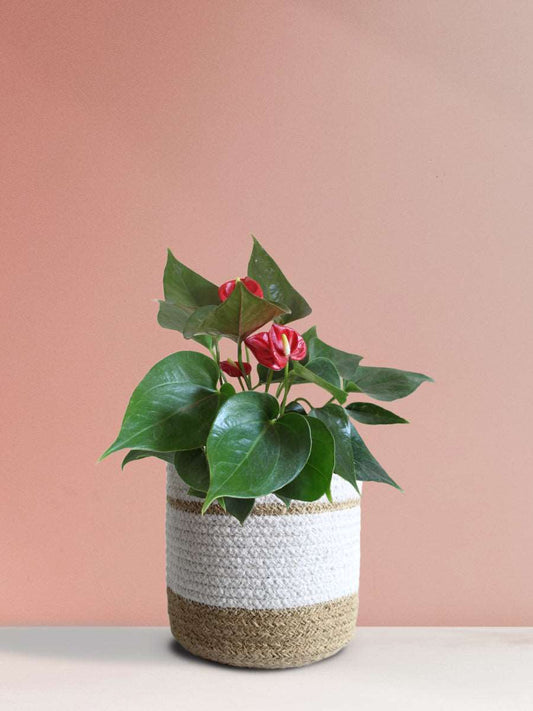
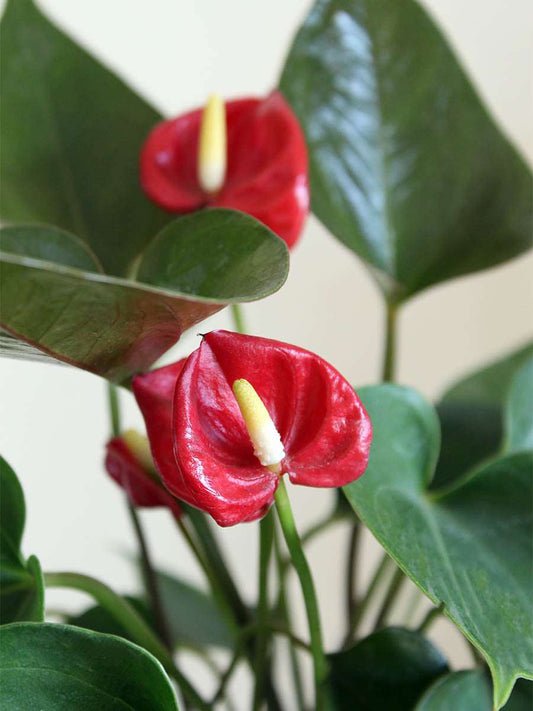 20% Off
20% OffAnthurium Mini Red (Medium)
Regular price From ₹ 879Regular priceUnit price per₹ 1,099Sale price From ₹ 879Sale -
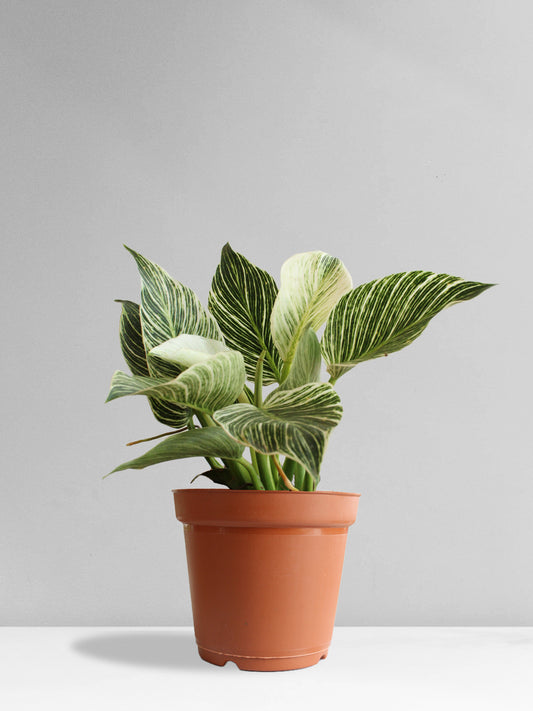
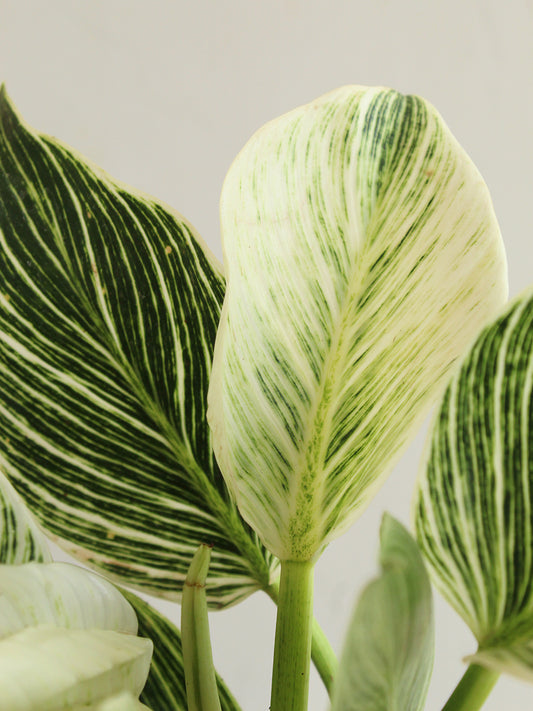 25% Off
25% OffPhilodendron Birkin (Large)
Regular price From ₹ 861Regular priceUnit price per₹ 1,149Sale price From ₹ 861Sale -
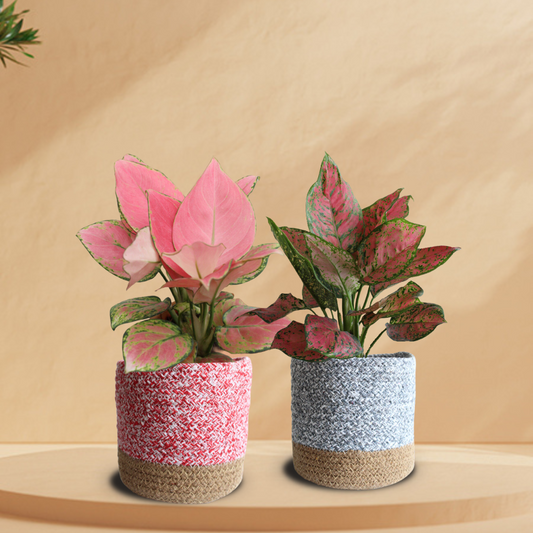
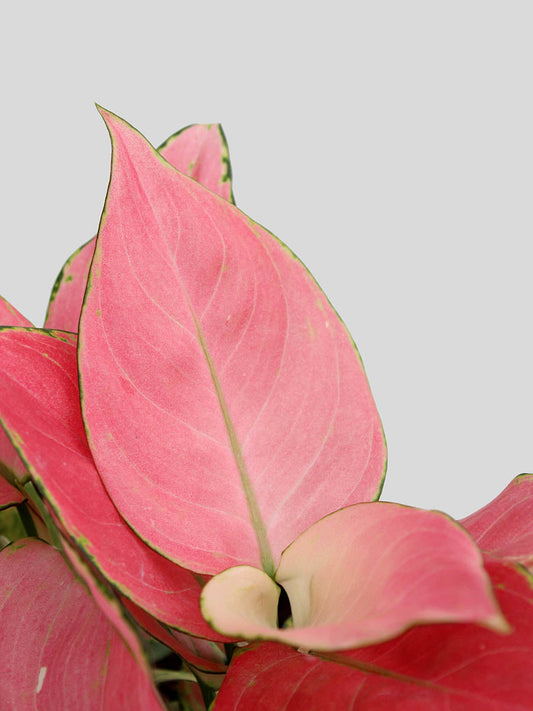 30% Off
30% OffLovely Pink Duo
Regular price ₹ 1,889Regular priceUnit price per₹ 2,699Sale price ₹ 1,889Sale -
Easy-Care Air-Purifying Plants Combo
Regular price ₹ 5,286Regular priceUnit price per₹ 7,049Sale price ₹ 5,286Sale -
Snake Plant Silver Queen (Medium)
Regular price From ₹ 799Regular priceUnit price per₹ 999Sale price From ₹ 799Sale -
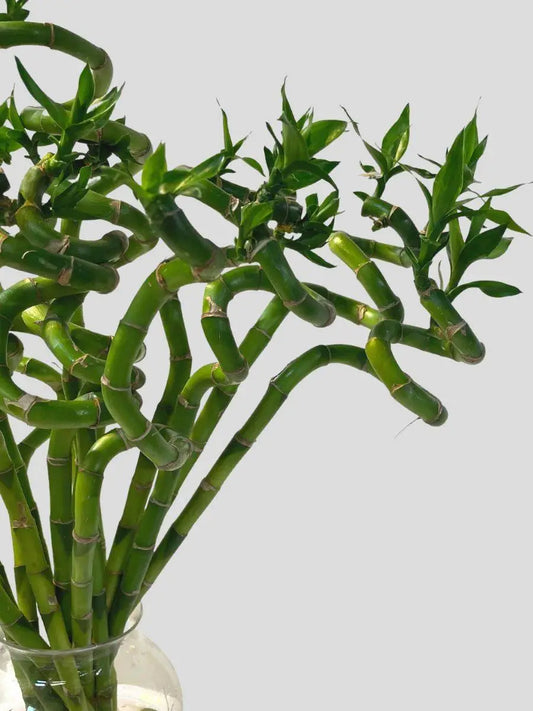
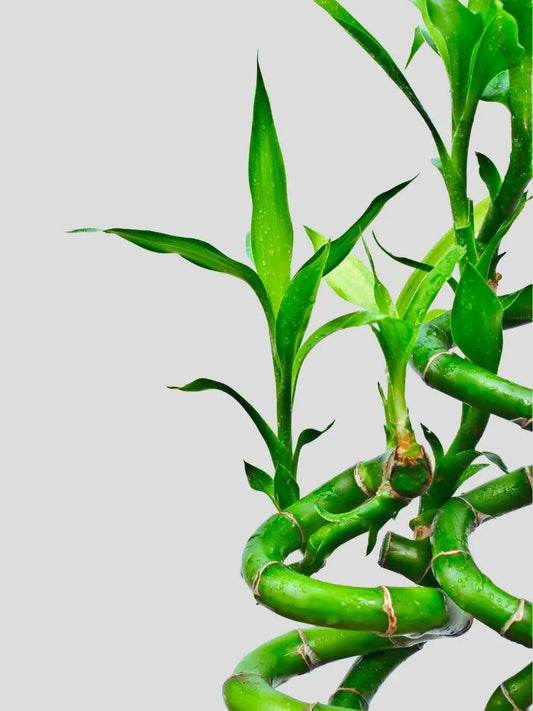 20% Off
20% OffLucky Bamboo Plant
Regular price From ₹ 880Regular priceUnit price per₹ 1,100Sale price From ₹ 880Sale -
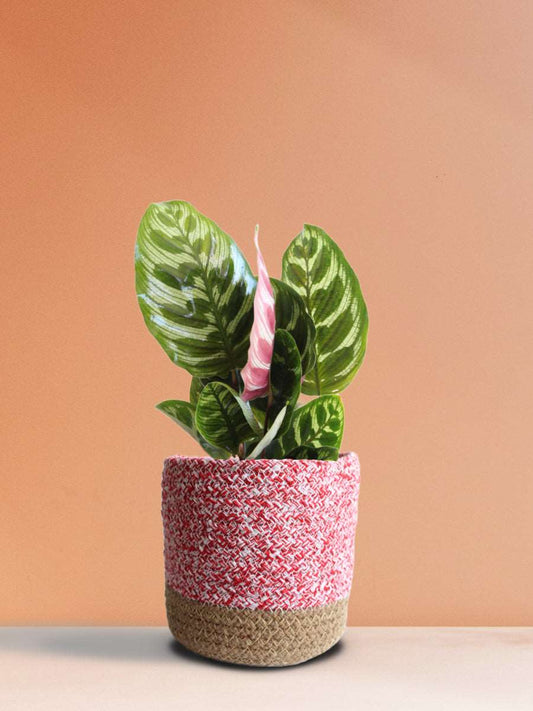
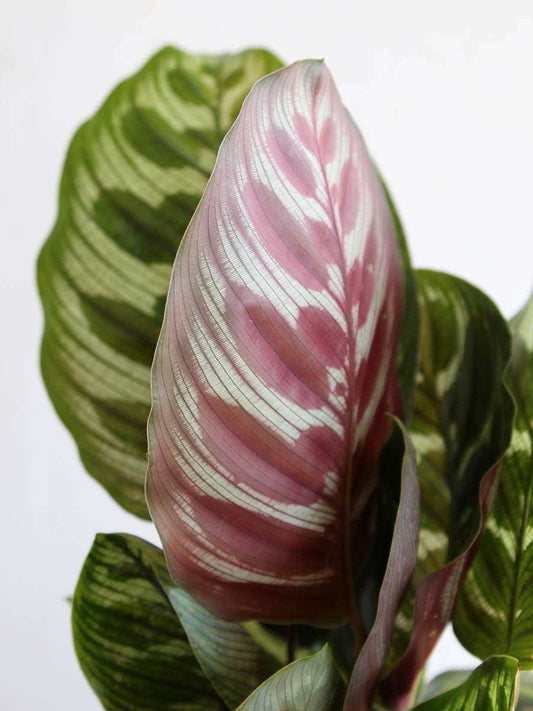 20% Off
20% OffCalathea Peacock (Medium)
Regular price From ₹ 1,079Regular priceUnit price per₹ 1,349Sale price From ₹ 1,079Sale -
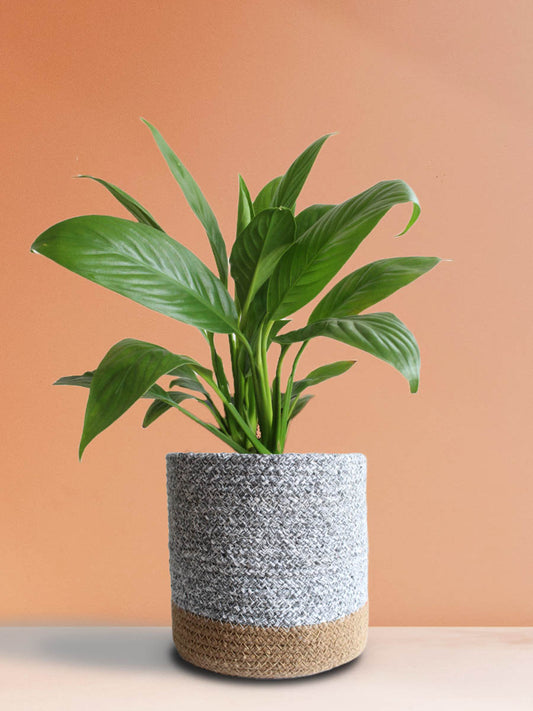
 20% Off
20% OffPeace Lily (Large)
Regular price From ₹ 959Regular priceUnit price per₹ 1,199Sale price From ₹ 959Sale -
Adenium Desert Rose Any Color (Large)
Regular price From ₹ 1,239Regular priceUnit price per₹ 1,549Sale price From ₹ 1,239Sale -
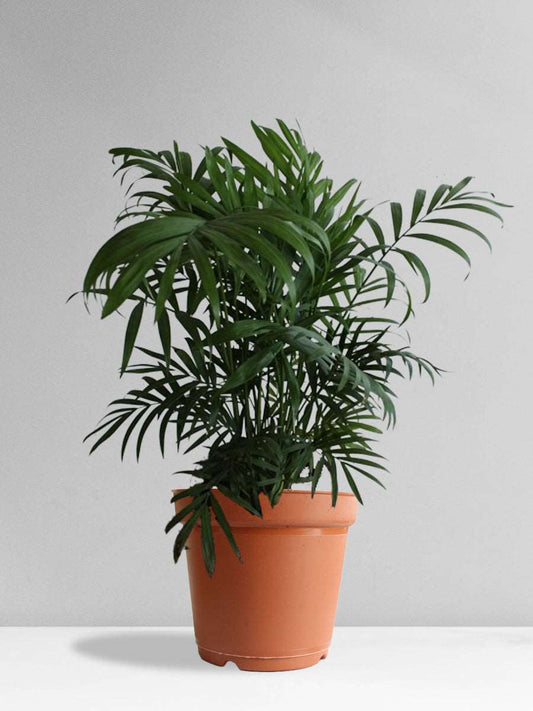
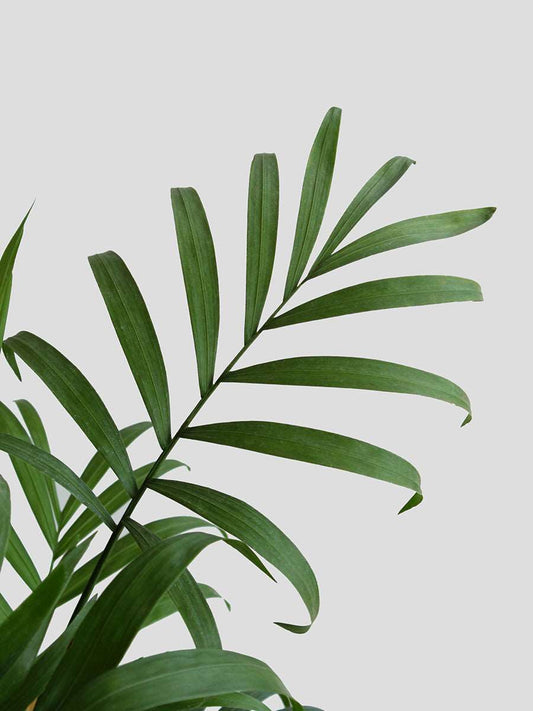 30% Off
30% OffChamaedorea Palm (Large)
Regular price From ₹ 839Regular priceUnit price per₹ 1,199Sale price From ₹ 839Sale -
Air-Purifying Flowering Plants Combo
Regular price ₹ 5,061Regular priceUnit price per₹ 6,749Sale price ₹ 5,061Sale -
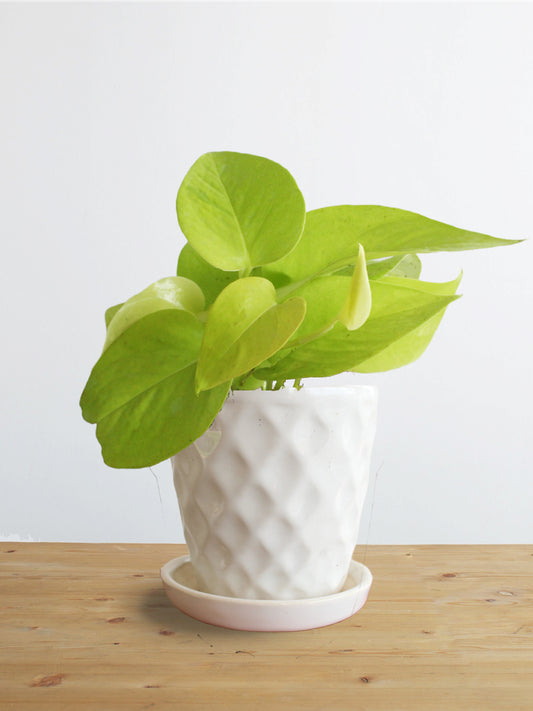
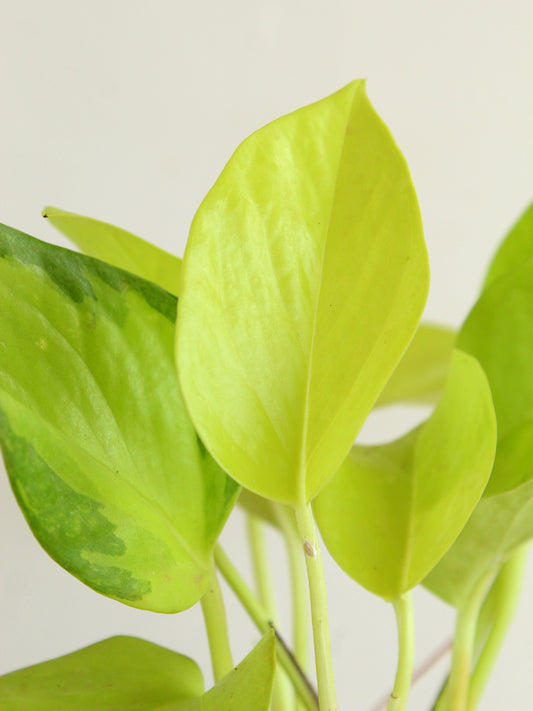 25% Off
25% OffMoney Plant Golden (Small)
Regular price From ₹ 561Regular priceUnit price per₹ 749Sale price From ₹ 561Sale -
Goodluck Charm Easy Care Plants Combo
Regular price ₹ 2,344Regular priceUnit price per₹ 3,349Sale price ₹ 2,344Sale -
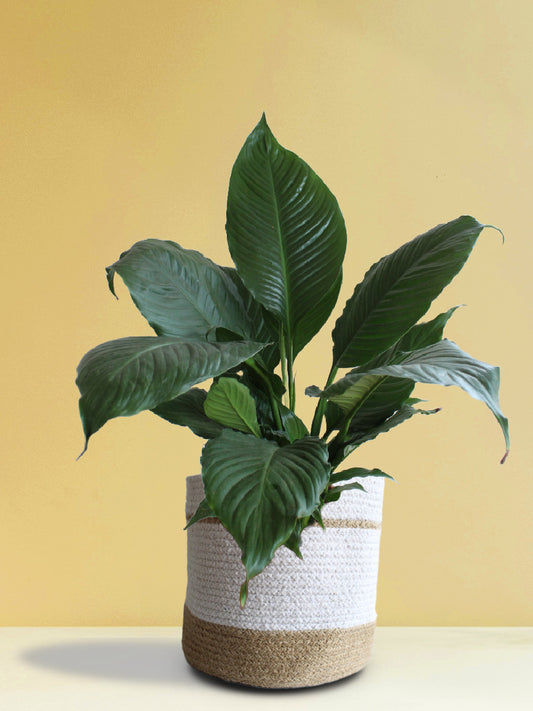
 20% Off
20% OffPeace Lily (X-Large)
Regular price From ₹ 1,839Regular priceUnit price per₹ 2,299Sale price From ₹ 1,839Sale -
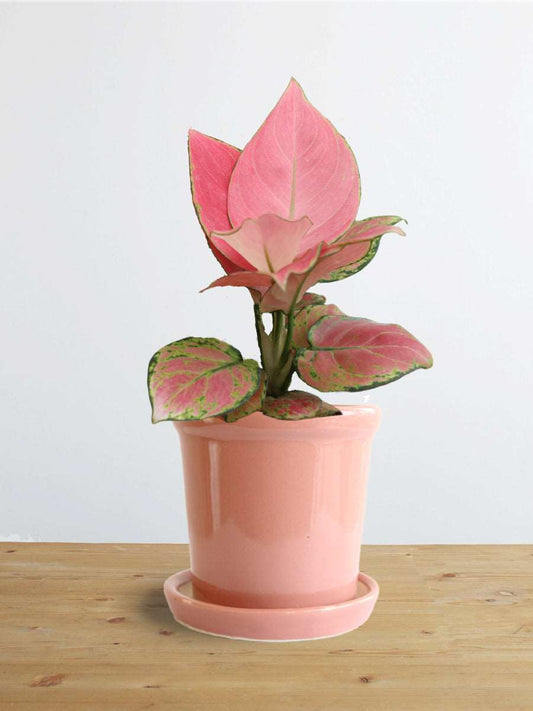
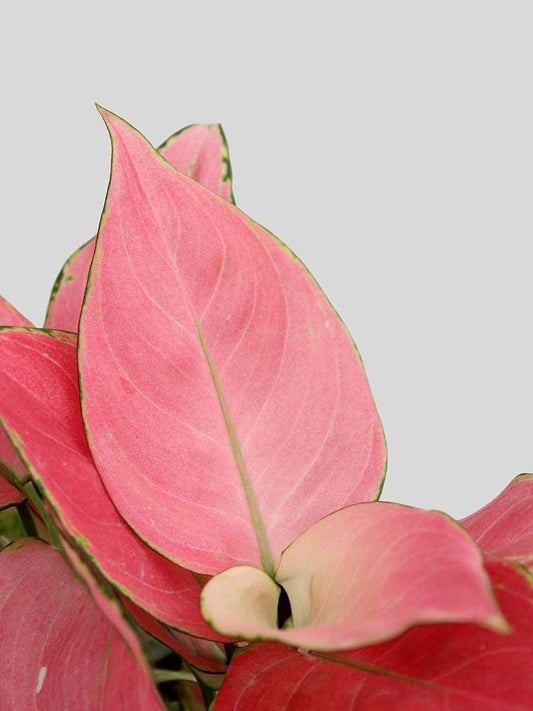 20% Off
20% OffAglaonema Pink Anjamani (Small)
Regular price From ₹ 839Regular priceUnit price per₹ 1,049Sale price From ₹ 839Sale
Buy Indoor Plants Online
Scroll down to learn everything about indoor plants for home and workplace, including their benefits and differences from outdoor plants. Find out about the best indoor plants for your home, tips to use for decorating a space with beautiful indoor plants, Vastu and Feng Shui tips for indoor plants, how to take care of indoor plants, and learn about the best fancy indoor plants for gifting. In addition, you'll find links to a wide selection of houseplants on this page.
What are indoor plants, and how do they differ from outdoor plants?
Indoor plants is a term used to describe plants that can be kept in an indoor setting, like homes, cafes, offices, and other closed spaces. Indoor plants, also called houseplants, are often found in nature in places where they grow without direct sunlight. Direct sunlight is generally harmful for such indoor plants.
The term 'Outdoor plants' on the other hand, is commonly used to describe plants that can be planted in gardens, or kept in balconies that receive full sunlight. These plants, unlike indoor plants, thrive in full sun and will not be able to survive in indoor environments.
Different climate conditions are required for indoor plants and outdoor plants. Indoor plants need a controlled environment, they grow inside closed living spaces, where the temperature, lighting, and environment can be changed to meet their needs. Outdoor plants can withstand climate fluctuations better and thrive in open air.
A major difference between indoor plants and outdoor plants is the type of roots that they develop. Most of the indoor plants like Aglaonemas, Philodendrons, and Anthuriums have thick and small roots. They do not require a very large pot, and also do well in porous soil mix. Most of the outdoor plants like Rose, Hibiscus, and Tulsi have thin and long roots forming a very intricate structure. These roots grow far and wide, and hence need bigger pots. Also, these plants need hard soil, which primarily consists of garden soil. Porous soil isn't good for most outdoor plants.
Furthermore, outdoor plants generally need watering everyday, since their soil dries up rather quickly. Indoor plants on the other hand should be watered only when their soil turns dry, which could be anywhere between once in a fortnight to two times a week.
Benefits of Indoor Plants
Have you ever noticed that when you're irritated or sad, walking outside makes you feel so much better? The same is true when you introduce nature into a setting, such as by bringing plants indoors. How? Learn the research-based evidence on the benefits of having indoor plants at home, in the workplace, in hospitals, in cafes, and in other interior places:
- Indoor Plants Offer Aesthetic Value: Adding beautiful indoor plants to an interior space enhances the appeal of the space. The visual characteristics of indoor plants make the environment interesting, diverse, and beautiful. Indoor plants have varied foliage in different unique forms and different colors. Interior spaces can be stylized to create unique settings with indoor plants. For example, you may keep plants in vacant room corners, keep plants on tabletops, hang plants from the ceiling, make a plant wall or shelf, or add plants to a vase or terrarium. Choosing an indoor plant for room decoration depends on its type and the room's design.
- Indoor Plants Enhance Indoor Air Quality: Like all plants, indoor plants absorb carbon dioxide and release oxygen. Certain indoor plants like Snake Plant and Rubber Plant can produce oxygen throughout the day as well as the night. Such houseplants are now commonly called 'Oxygen Plants'.
Moreover, according to NASA's 1989 Clean Air Study, certain indoor plants can potentially remove volatile organic pollutants like formaldehyde, benzene, toluene, xylene, and trichloroethylene. A process called phytoremediation lets some plants get rid of airborne pollutants and make indoor air quality better. - Indoor Plants reduce dust and other Particulate Matter: Urban cities have been under a constant pressure of rising dust particles and other particulate matter due to ongoing civil work and constructions. Certain plants like Pothos and Areca Palm are excellent at reducing such pollutants from the air we breathe. Common dust related health issues like skin rashes, dry eyes, and itchy skin can be avoided by placing indoor plants at home.
- Indoor Plants Act As A Natural Humidifier: Indoor plants release moisture into the atmosphere as they transpire. Because of this, indoor plants can help in increasing humidity. This helps in overcoming dryness in the indoor air. Thus, plants act as a natural humidifier and maintain humidity in the right range for human health.
- Indoor Plants Serve As Calming Therapy: Indoor gardening, often called horticulture therapy, improves the mental health of people with anxiety, depression, and dementia. Many medical clinics include potted plants in their waiting rooms to relax patients. Plants are known to reduce stress levels and create a calm aura. Overall, indoor gardening is fun, rewarding, and a good activity for the human mind and body.
- Indoor plants may help to minimize The e-device radiation: According to study, plants can absorb the non-ionizing radio waves emitted by electronic devices. Around 70% of plants can sense these waves, which can travel deep into the human body. These short wavelengths can result in headaches, fatigue, and depression. Primarily, photosynthetically active radiation, or PAR, is light with wavelengths between 400 and 700 nm. Plants use this range of wavelengths for photosynthesis.
- Indoor Plants Boost Productivity and Creativity: Research shows that office plants boost productivity and creativity. Research by Texas A&M University and the University of Michigan shows that workplace plants improve concentration, memory, and error reduction. Even a brief time in nature improves memory and attention by 20%. A study from the Royal College of Agriculture in Cirencester, England, found that workplace plants improve concentration and ideation. They found that one plant per workspace reduced stress and improved workplace morale.
Also Check This: Best indoor plants to boost mental wellness - Indoor Plants Help To Connect with Nature: Indoor plants can help people feel closer to nature. It is great for those who live in cities or urban settings with limited outside access to stay connected with nature. Moreover, caring for a plant promotes responsibility while also integrating you to the natural world.
- Indoor Plants Improve Quality of Sleep: Some plants, such as jasmine and lavender, have been found in studies to improve sleep quality. This, along with the relaxation-inducing properties of plants and providing fresh oxygen at night, implies that having plants in your sleeping space will help you sleep better and wake up feeling more refreshed.
Certain indoor plants, such as Snake Plant, Peace Lily, Areca Palm, Aloe Vera, and more plants can release oxygen at night. So you can place indoor plants in your bedroom. They not only decorate your room, but also keep you healthy. - Indoor Plants Help To Accelerate Recovery: Green is recognized as a relaxing color. Having a houseplant in a patient's hospital room can help speed up the recovery process for many patients. Researchers have shown that having plants in a patient's hospital room can help them relax and speed up the healing process.
- Indoor Plants Help To Reduced Exhaustion: Studies have shown that indoor plants and flowers can reduce fatigue and increase attention and focus. Participants in this study felt more energized in rooms with indoor plants and flowers.
- Indoor Plants Help in reducing Noise pollution: Plants in your home or office can absorb noise too! This is especially beneficial in open-layout workspaces or high-ceiling areas because plants absorb sound, making it easier to concentrate. To reduce noise, place indoor plants around the space's perimeter rather than in the center, so sound reflects off the walls into the plant leaves.
Where can I find Indoor Plants?
It is difficult to find a good variety of indoor plants for home at local nurseries because indoor plants require a certain infrastructure for care and development, and local nurseries most often do not have such facilities. Because of excessive natural heat and light, local nurseries generally keep only outdoor plants like flowering plants (rose, hibiscus, bougainvillaea, jasmine, seasonal flowering plants), herbs (tulsi, basil, etc.), and other outdoor plants. Thankfully, Greenkin, the best online plant nursery for indoor plants, has a very large collection of exotic yet easy-care indoor plants that can thrive in different environments.
Along with an indoor plant, it is also important to understand the care requirements for the plant. Greenkin's website offers comprehensive care instructions for each plant, helping gardeners of all skill levels to keep their houseplants healthy.
Best Indoor Plants for Home
Buy indoor plants online to create a healthier and more vibrant home. Greenkin offers a wide range of beautiful indoor plants that are ideal for every home, traditional or modern. These plants purify the air, beautify a space, and contribute to better health. At Greenkin, you can find colorful indoor plants, indoor flowering plants, tabletop plants, and others like snake plants and rubber plants to suit your home's style and design. No matter how busy your schedule is, Greenkin has indoor plant options to brighten up your home.
Some of the best indoor plants for home are:
- Aglaonemas: Aglaonema plants are fancy indoor plants that have beautiful colored leaves. They come in many natural colors, which makes them a great way to make any room look more visually appealing.
- Snake Plants: Snake plants add elegance to any room with their vertical sword-like leaves. There are many varieties of Snake plants, ranging from small 4 inch tabletop plants to 3 ft tall corner plants. All varieties are great indoor plants as they are known to possess excellent air-purifying capabilities.
- Areca Palm: This indoor plant has feathery leaves, which are grouped together on a stalk and are called fronds. Due to its feathery foliage, this plant gives a room a tropical feel. Areca palm too, is known for excellent air purifying abilities.
- Rubber Plant: This interior plant is an attractive houseplant with a strong visual appeal. The plant has thick, waxy, oval leaves that come in various colors. The most popular Rubber plant variety is the burgundy variant, which has deep burgundy, almost black, leaves. Rubber plants are great indoor plants to create a modern vibe.
- Chamaedorea Palm: Like Areca Palm, this plant too has feather-shaped leaves. The fronds' leaves are heavily divided into many segments, which adds a touch of elegance to any space.
- ZZ Plant: ZZ is an indoor plant that has waxy, elliptical leaves growing symmetrically on fleshy, tapered stems. Its unique evergreen tropical and outstanding visually stunning dark green foliage can make a beautiful addition to the interior setting.
- Anthuriums: Anthuriums are flowering indoor plants that are perennials with blooming spathes or shield-like leaves. These plants with heart-shaped leaves and beautifully colored flowers are protective structures that bring charm to any room.
- Peace Lily: Peace lily is one of the most popular indoor plants. It has narrow stalks with white flowers and glossy green foliage. Its beautiful foliage adds elegance and stunning beauty to any interior space.
- Baby Rubber (Peperomia): This indoor plant is unique with waxy foliage, bright green, dark green, or variegated leaves. It beautifies any room with thick upright stems and oval, spoon-shaped leaves. The best part about this indoor plant is that it is pet-friendly and non-toxic, making it an excellent choice to keep on coffee tables.
- Philodendrons: The big, shiny leaves of philodendrons are usually dark green but can be yellow, red, or almost black. Some have spathes, modified leaves that surround a spike of tiny flowers. Philodendrons are beautiful indoor plants that can give an instant jungle vibe to your home.
Decorate Home with Indoor Plants
Buy indoor plants online to add green decor to your home. Indoor plants are more than just potted plants, they are an important aspect of interior designing. You can add beauty and peace to any environment for maximum visual effect with indoor plants for home. Trying these ideas below involves refreshing your home and bringing nature inside.
- Place beautiful indoor plants together: Grouping your indoor plants helps your space look richer and more welcoming. Place 2 or more plants together to create a more vibrant space. You can buy carefully selected plant duos and plant combos directly at Greenkin.
- Create a color palette with colorful indoor plants: Aglaonema, Anthurium, Philodendron, and other indoor plants have vivid colorful foliage. Use one or more interior plants to create a color palette within your home's interior.
- Add visual variation with indoor plants: Mix broad and narrow foliage interior plants. It makes your layout more attractive and interesting. For example, use a Chamaedorea Palm with long, slender leaves and a Rubber plant with large, thick, oval leaves to create a visual variation.
- Get creative with your space: Place indoor plants artfully on empty walls or spaces to provide greenery. Use shelves or hanging plants to provide vertical depth. Use big indoor plants for vacant corners and as section separators. Use small indoor plants to fill up shelves.
- Be creative with pots for indoor plants:For a distinctive indoor plant presentation, select a pot style that matches the rest of your home's decor. Use ceramic pots, metal pots, or eco series pots in various colors or choose planters like woven baskets. Combine these with stands and mix them with similar-colored and styled plants.
- Celebrate festivals with indoor plants decoration:Decorations with greenery offer nature and joy at festivals and events. Beautiful indoor plants for home may be hung in the backdrop, placed on tables, or used as indoor décor centerpieces.
Also Check This: Amazing Benefits Of Basket Planters For Your Plant
Artistic Indoor Plant Arrangements For Interior Spaces
There are many artistic ways for placing indoor plants to decorate your interior spaces, for example:
- Create a room divider with tall, leafy fancy indoor plants.
- Add antique planters or containers to corners, or pair potted plants with modern storage bins or baskets.
- A bookshelf with plants or books is another way to beautify homes and offices. Green is good for your health and mind, so incorporate some into your space. Mix plants among the books on a study desk or three-shelf bookcase in the living room to create a relaxing, cheerful look.
- Combine green fancy indoor plants with unique or sculptural furniture. For example, set up a meditation nook with some plants, crystals, candles, and wooden swing chairs.
- Fill a corner with large planters and many big plants to create a lush and tropical vibe. Another idea is to incorporate painted arches into the corner and decorate them with fancy indoor plants.
- Add vertical interest with hanging planters or shelves adorned with trailing plants. If you have low ceilings, consider hanging plants. Use metal shelves or ceiling planters to grow plants at eye level and add vertical elegance to the area.
- Combine beautiful indoor plants with an antique mirrored wall for a striking display. This will make your room appear larger. Also, use a thin dresser near a window or long mirror, and hang plants above to pull the eye upward and create visual interest.
Important Considerations for Indoor Plant Care
- Take your time choosing an interior plant that fits your space (bright, indirect, or low). Next, water indoor plants properly.
- Watering frequency, volume, and whether to water the soil or leaves depend on the plant and its preferences.
- Finally, as the days lengthen, rotate those plants periodically since they grow toward the light.
Read more: How To Care For Plants While You're Away
Vastu and Feng-shui Tips for Indoor Plants
Vastu Shastra, the ancient Indian architectural and design philosophy, says that fresh air from indoor plants can infuse positive energy into your living environment. You can bring love, consistency, and abundance into your home by choosing Vastu indoor plants.
Important Considerations for Plant Placement
Every plant has a certain orientation that allows you to get the most spiritual and scientific advantages. There are a few plants which are best for spreading positive energy at home.
- Large interior plants, such as lucky bamboo, are usually planted at the southeast corner of the residence. Put in this direction, they receive enough sunlight, bringing the necessary stability and prosperity to your house.
- Small interior plants (maximum 3 feet) such as tulsi are planted in the east or northeast direction. It infuses your home with wonderful energy.
Things to Remember for good Vastu
- Always trim your garden to keep plants in good condition.
- Decayed leaves and wilted petals should be thrown away since they draw bad energy.
- Cactus and other prickly plants should not be kept indoors, except roses. These have a negative impact on family relationships.
- Avoid growing creepers in your home since they quickly connect to neighboring walls and cause harm.
Care Guide for Indoor Plants
Caring for indoor plants requires knowledge of their specific needs. From how often to water them to how much light and humidity they require, this guide offers vital advice for keeping your indoor plants happy and healthy.
- Watering Schedule: Indoor plants generally should be watered once or twice a week, when the soil is dry. Some indoor plants, like Snake Plants and ZZ, like watering once every two weeks. Avoid overwatering indoor plants, as it will result in root rot.
- Sunlight Exposure: Indoor plants do not like direct sunlight beyond 9 a.m. Hence, keep them in mid to bright indirect light.
- Heat Tolerance: Most indoor plants are not heat-tolerant. Do not place your indoor plant next to a heat source like electronics that emit heat, gas burners, or glass windows that receive direct sunlight.
- Humidity: The indoor plants available on Greenkin's website do well in Indian weather. Some plants like Peace Lily and Homalomena Maggy require more humidity than others. It is a good practice to mist your indoor plants every day. For increased humidity for plant health, check thes 9 Ways to Increase Humidity.
- Regular Inspection of Pests: Insect pests, such as aphids and spider mites, should be checked on the plants on a regular basis, and appropriate measures should be taken to control them. This is another very important aspect of plant care.
Best Indoor Plants for Gifting
Plants definitely enhance any space, but they also serve a much deeper purpose. Understanding what different fancy indoor plants mean can help you speak the perfect thank you, best wishes note, or any other message to the person you're gifting a plant to without saying a word. Uncover the best plants to give and their symbolic significance.
- Anthurium: This indoor plant is a symbol of "hospitality", "love", and "prosperity". It may make an excellent gift for special occasions such as housewarmings or anniversaries.
- Peace Lily: As a symbol of "healing", "hope", and “other positive themes", the peace lily plant is an ideal present for the busy person who enjoys or wishes for a serene life.
- Aglaonema: Agalonema plants are indoor plants that represent "abundance", "purity", "prosperity", and “the positive energy of nature." This is a great gift for someone for "wishing a new chapter of life”.
- Birkin: Its striking variegation makes Birkin more than a pretty face in indoor plants. Its symbolism of health and abundance resonates with urban residents who want a touch of nature. This makes a great gift for someone who appreciates simplicity.
- Pothos: It is a lucky plant that represents “wealth” and "luck." It also symbolizes "resilience", "determination", and "positivity". Due to its rapid growth and versatility, it makes a great and meaningful gift for someone who is starting a new journey or personal growth.
Buy Indoor Plants Online with Greenkin
Ready to join the green home interior? Looking for perfect beautiful indoor plants online for your bedroom, bathroom, kitchen, living room, workplace, and more? Greenkin has a variety of indoor plant options (indoor plants online shopping) for completing your search. Visit Greenkin's website today to see our wide collection of high-quality indoor plants to beautify your home or give a thoughtful gift for various occasions.
Greenkin provides high-quality, exotic indoor plants for home at your doorstep with a few clicks. Browse greenkin's beautiful indoor plants, add the ones you like to the cart, and enjoy a seamless checkout experience. So buy indoor plants online and have them delivered to your doorstep. Enjoy gardening without leaving the comfort of your home. Each Greenkin indoor plant comes with a lovely pot suitable for interior decoration or giving gifts on special occasions. Additionally, Greenkin promises excellence as a trustworthy green partner. Each plant is checked for health, size, and growth before shipping.
So why wait? Join the Greenkin indoor shift and develop an enhanced connection with nature in your indoor setting. Go Green By Bringing Nature Indoors!
FAQ
Indoor plants, also called houseplants, are decorative plants grown indoors. They are used in homes and offices for the dual purpose of making an interior space more aesthetically pleasing and functionally effective by improving air quality and other health benefits.
Indoor plants, according to Vastu Shastra, can help in maintaining the balance and flow of the home's vitality. Additionally, they have the potential to impact the prosperity, health, and wealth of the residents.
According to Vastu, small plants should be put in the east or northeast to bring good energy into the home. Large plants should be put in the southeast corner so they can get plenty of sunlight, which is considered to bring stability and wealth to the home.
According to Vasu principles, it's important to trim indoor plants regularly, dispose of decayed leaves and wilted petals quickly, and avoid keeping prickly indoor plants like cactus indoors, except for roses.
There are many indoor plants that are easy to care for and ideal for beginners, such as the spider plant, pothos, snake plant, zz plant, and more. They are resilient and can endure a wide range of indoor environmental conditions.
According to Vastu, each indoor plant should be placed in a certain way to get the most spiritual and scientific benefits from it. Putting indoor plants in the right place is thought to boost the positive energy in the area, making it more balanced and peaceful.
Indoor plants have many benefits, such as lowering stress, improving focus, helping with therapy, speeding up recovery from illness, enhancing productivity, and more. Scientific evidence supports these advantages.
Yes, indoor plants can enhance the quality of the air by absorbing toxic compounds and releasing oxygen. NASA's 1989 Clean Air Study demonstrated that some indoor plants can eliminate formaldehyde, benzene, toluene, xylene, and trichloroethylene.
Yes, placing indoor plants inside can raise the oxygen level. At night, photosynthesis stops, and indoor plants normally breathe like people, taking in oxygen and letting out carbon dioxide. However, snake plant, areca palm, tulsi, spider plant and more indoor plant do the opposite, taking in carbon dioxide and enabling oxygen.
The snake plant, also known as mother-in-law's tongue and sansevieria, is a popular, attractive, easy-to-grow plant that provides oxygen 24/7 and thrives in low light.
All plant species are capable of absorbing radiation to some extent. However, no studies have shown that indoor plants completely protect against high radiation levels. Although it has been demonstrated that spreading indoor plants across your home or workspace will reduce EMF levels by 30% while also purifying the air.
When selecting an indoor plant, consider the lighting conditions, temperature, and humidity levels in your room. Choose indoor plants that flourish in the exact conditions of your surroundings.
Yes, indoor plants effectively control dust, and their leaves filter dust to prevent potential issues. According to theory, indoor plants release harmful charged particles called negative ions. Negative ions "reverse" the charge of air molecules. Just as static electricity causes socks and other pieces of clothing to stay together, negative ions make particles in the air bind together and become heavy, which causes heavy particles to fall out of the air.
Dust and other particulates from buildings and civil activity are constantly bombarding urban areas. For example, pothos, areca palm, and other indoor plants help reduce dust and other particles, as well as air pollution. Moreover, indoor plants can prevent dust-related skin rashes, dry eyes, and itchy skin.
When selecting an indoor plant, consider the lighting conditions, temperature, and humidity levels in your room. Choose indoor plants that flourish in the exact conditions of your surroundings.
Indoor indoor plants such as snake indoor plants, zz indoor plants, and pothos thrive in low-light environments and can be ideal for offices or areas with inadequate lighting spaces.
To prevent indoor plants from drying out during hot weather, keep the home cooler and lower the humidity by watering them more often or using a humidifier. Keep the indoor plants out of direct sunlight, and keep the soil moist yet well-drained.
Many indoor plants can be propagated in water with ease. You can make cuttings from them and place the cut ends in a glass of water.
Your indoor plant may lack humidity if its leaves droop or turn brown. To increase humidity, mist the plant with water several times per week, use a humidifier, or place all of the pots on top of a small tray of water.
Indoor plants can get bushy if not maintained regularly. Use clean, sharp scissors or pruning shears to remove dead or yellowing leaves, stems, or blooms. Additionally, remove excess growth to maintain the form.
All indoor plants, including snake indoor plants, spider indoor plants, peace lilies, and more, have good air-purifying properties and can remove hazardous toxins from the air.
Indoor plants can turn yellow at any stage, depending on their species, genus, or other classification and environmental conditions.
Indoor gardening relieves stress, boosts creativity, productivity, and focus, and promotes recovery. There's some evidence that indoor plants may positively influence the air quality in your home as well. It's important to know which indoor plants are toxic if you have children or pets in the home.
Many indoor plants, but not all, can be grown in water, which involves immersing the plant's stem in water until roots form before planting it in soil. Follow the propagation instructions particular to each species.
Well-drained soil with adequate air circulation and water retention. For improved drainage and air circulation, use a potting mix that includes perlite, vermiculite, or sand. Some store-bought mixes contain these ingredients, which are beneficial to indoor plants.
Good, sleeping in a room with indoor plants is safe for people. Snake Plant, Areca Palm, Aloe Vera, Tulsi, Spider Plant, and other indoor plants that release oxygen at night can add liveliness and beauty to the living room or bedroom.
Indoor plants may need repotting if their roots grow out of the drainage holes. Also, if the soil becomes excessively compacted and water sits on top of the soil instead of being absorbed, it is time to repot your indoor plant.
Some indoor plants are believed to bring good luck, according to certain cultural beliefs and traditions. For example, the pothos or money plant is often associated with wealth and prosperity, while the lucky bamboo plant is believed to bring good fortune and positive energy. Additionally, the jade plant is considered a symbol of good luck and success in many cultures.
During the winter, your indoor plants may require less water and fertilizer since their growth rate slows due to limited sunlight. Additionally, shield your indoor plants from cold drafts and heat sources.
Indoor plants require frequent fertilization to stay healthy. Use a balanced formula that includes equal amounts of nitrogen, phosphorus, and potassium. Follow the label's instructions for the amount to be administered.
Some pests, such as mealy bugs or spider mites, may try to make a new home in your indoor plants when you bring them inside from the outdoors. If bugs appear on indoor plants, clean them with natural liquid detergent or soapy water.
Most indoor plants can be propagated through stem cuttings or division. Choose healthy plant components and follow the appropriate propagation guidelines for each species of plant.
Dust doesn't harm indoor plants, but too much can restrict light, photosynthesis, and growth. A quick wipe with a moist cloth or sponge should suffice to eliminate the dust. This will work for most indoor plants, but if the leaf surface has sticky residue or brown lumps, wash with a mild soap solution with a few drops of cooking oil.
Indoor plants need light, but not from a window. Grow lights may be needed if they don't get enough from window direct sunlight.
Insufficient light causes leggy indoor plants. The simplest way to minimize leggy growth in indoor plants is to set them near a bright window with indirect lighting or supplement natural light with artificial fluorescent lights.
Indoor plants generally thrive in temperatures between 60 and 90°F (15 and 32°C). However, it is important to note that different plants have different temperature preferences, so it is suggested to research the specific needs of each plant before placing them in your interior space.
Yes, indoor plants can attract insects. If you have indoor plants, inspect them on a regular basis for symptoms of infestation.
Droopy nods, yellow leaf edges, and leaf drops indicate a low-light indoor plant. Pot indoor plants at a southern or eastern window with bright indirect light. If you don't have a position like that for your plant, a sunny window is adequate. If a window is inaccessible, supplement with artificial grow lights.
Fungus or mold growth is the root cause of root rot. Specifically, the fungus, or mold, needs moisture to survive. So, make sure to repot your indoor plants in well-drained soil that allows water to escape. Never let your plant stand in water. Make sure the water drains from the container's bottom.
If the roots are beginning to emerge from the drainage holes or the soil is compacted and water is not being absorbed, it is time to repot in a larger container.
Yes, you can place indoor plants in your bathroom. Many individuals keep houseplants in their bathrooms because of the high humidity there—almost like a tropical rainforest—which is perfect for many kinds of houseplants. Houseplants that love humidity absorb extra water, cleansing the air and preventing mold growth.
Good, sleeping in a room with indoor plants is safe for people. Snake Plant, Areca Palm, Aloe Vera, Tulsi, Spider Plant, and other indoor plants that release oxygen at night can add liveliness and beauty to the living room or bedroom.
Some ways to make indoor plants take up less space in your home are to use backless cabinets, mount shelves on the walls, hang indoor plants from used stairs, use clothing racks and put indoor plants on top of the shelves, and even put indoor plants on window sills!
According to a study published in the Journal of Physiological Anthropology, having indoor plants in your home and office can help you feel more relaxed, comforted, and natural.
A few ideas include arranging indoor plants in odd numbers, using varied sizes of indoor plants, considering leaf shapes and colors as well as plant color, and using multiple colorful pots. Remember, don't forget to water your indoor plants.
Yes, indoor plants are the ideal gift for a birthday, housewarming, thank-you and other occasions. Additionally, indoor plants are great gifts for any time of the year because they last a long time, are important, and are eco-friendly. Each plant represents something with a different deep meaning.
Yes, indoor plants are an aesthetic decorating item, along with an eco-friendly item to upgrade any environment and improve your family's health. House indoor plants add freshness, bring the outdoors in, and make your home seem cozy. Adding indoor plants to your home design will freshen up your home and mind.
According to NASA research, 15 to 18 suitable-sized indoor plants are necessary in a space of 1,800 square feet (167 square meters) to effectively purify the air in a home.









